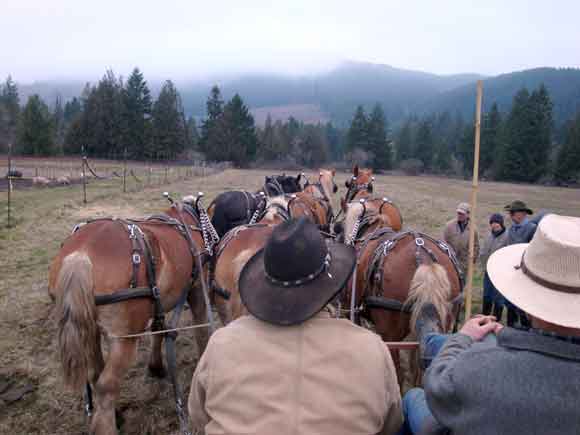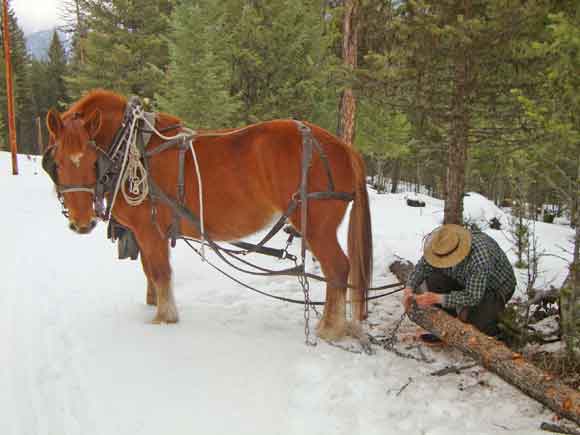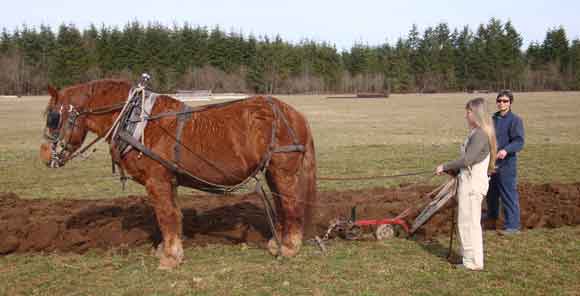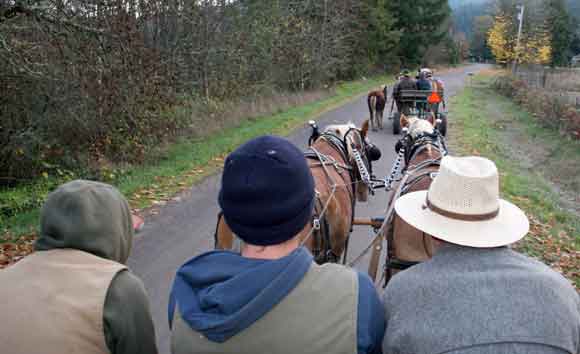Where Driving Differs

For driving, both the horses and the people must be better trained than for riding.
“Every time we put one or more horses to something for them to pull, I feel we have an even greater responsibility than when riding. If we fall off when riding and the horse takes off with riding tack –saddle and bridle and such – it’s not likely that there will be great physical and psychological damage to the horse. However, when driving horses that are hitched to a vehicle, a piece of equipment, or a log – if the horse takes off, the potential for both physical and psychological damage is huge.
“For this reason, I feel that both the horses and the people involved in driving need to be better trained than they do for riding. In addition, we as drivers need to be more attentive, observant and cautious than the average horseback rider. We have to be willing to put our agenda aside and, if necessary, change what we are doing or how we are doing it in order to help our horses stay comfortable and relaxed. Comfortable, relaxed horses are less likely to have close calls, mishaps, wrecks and runaways.
“From my perspective, the top priority of horsewomen and horsemen must be to keep our horses relaxed and comfortable at all times. Even when we need our horses to perform at speed or with great effort, they perform better in a comfortable, relaxed mindset. As drivers we may need to abandon our personal goals and deal with whatever is necessary each and every moment to ensure our horses’ emotional, psychological and physical needs are met. Of course, I’m not saying we should let our horses have their own way. The challenge is to help them accept what we as e leader are asking without getting in a fight over it.”
Stopping well, standing still and staying put are the most important “gaits” for any driving horse.
“If a saddle horse moves without being asked to do so, the rider simply goes with them. However, there are many times when it is not safe for driving horses to make the choice to move on their own. For example, we do not want our horses to move in any way when we are hitching, when we or our passengers are getting on or off of a vehicle or equipment, or when we are making adjustments to harness, line, or other equipment.
“One of the first and most important things a driving horse should learn is to stop promptly on command and stand still until asked to go. This needs to be taught on the ground before horses are ever harnessed. Lives depend upon this. If they won’t stand on a halter, we can’t expect them to stand when hitched. This needs to be taught and reinforced on an ongoing basis. If we’re working on the ground and they move a foot, we need to put that foot back. The same is true when we have them standing in harness. If we allow them to move one foot, we are giving them permission to make the choice to move on their own. Horses that will not stand are not yet ready to be driven.”

“When we drive horses, because the only physical contact we have with our horses is via the driving lines to the bit, verbal cues are very important. When riding, we have our legs and seat in contact with the horse; we can shift our weight or balance and can touch the horse with our hands. When we’re driving, our voice becomes a relatively more important tool to compensate for our lack of ability to cue, touch and comfort our horses with our body and hands.
“That being said, we need to understand that horses don’t automatically understand what we’re trying to get them to do with our voice commands. We have to teach them what particular words mean. It’s entirely possible that we could teach a horse to go when we said ‘whoa’ and stop when we said their name and kissed or when we said ‘walk on,’ ‘get up,’ or other usual commands to start; it’s just a matter of conditioned associations. We need to help them make an association between the word we’re using and the desired action or response we want from them.
“My goal when driving is to be extremely consistent with the words I use and how I use them. I am very conscious and disciplined; specifically I don’t want to confuse or desensitize my horses with meaningless verbal chatter. A good example of where I’m very consistent, conscious and disciplined is in how I use a horse’s name. The only time I speak a horse’s name when driving is when I want them to start forward or when I ask them to move forward faster if they are moving too slow. To start my horse Ann, for example, I use physical cues on the lines and a corresponding verbal cue that starts with, ‘Ann,’ followed by a kiss sound. If I wanted Ann to back up I would never say ‘Ann, back,’ or ‘back, Ann’ because her name is only for forward motion.”
Drivers need to be very, very skilled with their hands.
“Whenever I think about the differences between riding and driving, there’s a saying that comes to mind: it takes five years to develop legs, 10 years to develop a seat and a lifetime to develop hands. As I mentioned before, as drivers we aren’t able to communicate via our legs or our seat. Our only physical contact with our driving horses is through our hands. Consequently, for us to be effective and safe and not confuse and torture our horses too much, we need to become very, very skilled with our hands. And then we have to skillfully blend our voice commands with what we’re doing on the lines.”

Drivers must be scrupulous about paying attention.
“I cannot emphasize enough the importance of keeping our attention on our animals at all times when in harness. I recently saw a photograph someone took of me at a clinic, and I was really disappointed that the driver shown in the photo was looking at me and not at her horses. No one else in the photo was paying attention to the horses either. We must be scrupulous about maintaining a constant conscious connection with them. We must do this not just through our hands on the driving lines and with our eyes and with our voice, but also with our intention, our thoughts, and our emotions.”Drivers have to be more aware of communication via the bit.
“Horses are into-pressure-animals. When they feel steady pressure on a part of their body, their natural tendency is to push back against that pressure rather than move away from it. This is why they will pull loads in harness for us. When we put a horse in harness and hitch them to a reasonable load and ease them forward into the load, they feel steady pressure on their shoulders. Their natural inclination is to push into the collar against the steady pressure of the load. We can train horses to pull very heavy loads by rewarding and promoting this natural behavior. If the load (draft) increases, such as when we go up a hill, the horse feels greater steady pressure and tends to push into the load harder. This is the reason horses tend to speed up when pulling a hill or whenever the load (draft) increases due to changes in ground conditions.
“I often see people driving with constant, steady pressure on the bit. This is not a very effective way to work with horses. If we hold steady pressure on the bit, the horse is inclined, by nature, to push against it. The horse usually speeds up and becomes anxious, which typically results in the driver holding back with greater steady pressure. The horse then responds by pushing harder against the greater pressure on the bit. A tug of war develops. Trying to slow down or hold back a horse with steady pressure on the bit, especially on both sides of the bit at once, is one of the worst things we can do to them and to our relationship with them.
“Because, as drivers, our physical communication with our horses is primarily via the bit, we must be more aware of our technique than riders or we lose a major way to interact with our horses. We just can’t use steady pressure and expect our horses to work optimally for us. We must strive for perfect contact with the bit, and perfect contact is a constantly moving target. If we drive in such a way that there is slack in our lines, for instance when things are going well or we’re going straight down the road or our horses are following the furrow, and we only communicate when there needs to be a change, in between times we aren’t there for the horses. If they’re not feeling us on those lines, it’s like a teacher who has left their classroom or a boss who has left the office. The horses will start making decisions on their own. Finding perfect contact with the bit and maintaining it at all times is crucial for our horses to work optimally. They need us to continuously give them our direction, encouragement, support, and approval or disapproval.

Driving with a rhythmic way of handling the lines greatly benefits our horses.
“Horses are very rhythmic animals, and, if we can connect with that rhythm, we can ‘talk’ to them through it. When riding, they create the rhythm as their bodies move, and our body tends to move with it. We can also move our body in ways that influence their rhythm and affect their mind and way of going. However, when we are driving them, their rhythm is not transferred to our body in a way that we can feel it directly, because we are either walking or riding on something behind them. The only way we can harmonize with or change their rhythm is with a rhythmic handling of the lines. If our hands are on the lines, moving as our horses move, and we are pulsing, squeezing, or massaging the lines with our hands, then we can be constantly ‘talking’ to our horses via the bit. We can be sending approval for what they are doing and how they are doing it, or asking for a change if need be.
“With practice, it is possible to develop an amazingly gentle, horse-friendly, and effective system of communication with driving horses using rhythmic hand movements. With practice, it becomes possible to skillfully and with finesse change pressure and send artful cues down the lines. I have come to call this style of driving ‘rhythmic pressurerelease driving’ (formerly referred to it as ‘see-saw’ in my DVDs). In my experience, this pressure release driving technique has helped a tremendous number of people improve their driving and their relationships with their horses when in harness. More than anything else I teach, it has helped horses to become more comfortable and to be more willing workers.”
Drivers must be more aware of non verbal, non-physical communication.
“Because of our limited physical connection with our horses, as drivers we must be more attuned to the many other ways that we communicate with them. Horses are very adept at reading us; they can determine our emotional states extremely accurately by ‘reading’ our muscles and our voice. We can fool other people, and we can fool ourselves, but we cannot fool horses. Horses always perceive the true emotions that are going on inside of us regardless of our voice and body language. They can detect the slightest intensity, anxiety, concern, fear, uncertainty, irritation, or impatience within us, and they will respond to us with this knowledge in mind. If we don’t get the reaction from our horse that we expect, we need to ask how we might be creating the wrong reaction. Horses are amazing at recognizing when we are incongruent.
Jenifer Morrissey works her draft ponies in Gould, Colorado.
This article appeared in the August/September 2012 issue of Rural Heritage magazine.
